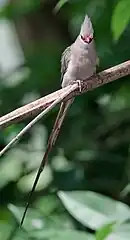| Urocolius[1] | |||
| Bonaparte, 1854[2] | |||
 Przedstawiciel rodzaju – czepiga długosterna (U. macrourus) | |||
| Systematyka | |||
| Domena | |||
|---|---|---|---|
| Królestwo | |||
| Typ | |||
| Podtyp | |||
| Gromada | |||
| Podgromada | |||
| Infragromada | |||
| Rząd | |||
| Rodzina | |||
| Rodzaj |
Urocolius | ||
| Typ nomenklatoryczny | |||
|
Lanius macrourus Linnaeus, 1766 | |||
| Synonimy | |||
|
| |||
| Gatunki | |||
| |||
Zasięg występowania
Charakterystyka
Długość ciała 29–37 cm (w tym ogon o dł. 19–28 cm); masa ciała 32,5–78,9 g[5]. Od rodzaju Colius przedstawicieli Urocolius odróżniają następujące cechy[6]:
Systematyka
Etymologia
- Urocolius: gr. ουρα oura „ogon”; rodzaj Colius Brisson, 1760[7].
- Limnatornis: gr. λιμνατις limnatis „żyjący na bagnach”, od λιμνη limnē „bagno”; ορνις ornis, ορνιθος ornithos „ptak”[8]. Gatunek typowy: †Limnatornis paludicola A. Milne-Edwards, 1870.
- Palaeopicus: gr. παλαιος palaios „stary, antyczny”; gr. πικος pikos „dzięcioł”, od łac. picus „dzięcioł”[9]. Gatunek typowy: †Limnatornis paludicola A. Milne-Edwards, 1870.
Podział systematyczny
Do rodzaju należą następujące gatunki[10]:
- Urocolius macrourus (Linnaeus, 1766) – czepiga długosterna
- Urocolius indicus (Latham, 1790) – czepiga czerwonolica
Przypisy
- ↑ Urocolius, [w:] Integrated Taxonomic Information System (ang.).
- ↑ Ch.L. Bonaparte. Conspectus volucrum anisodactylorum. „Ateneo italiano”. 2, s. 313, 1854. (wł.).
- ↑ A. Milne-Edwards: Recherches anatomiques et paléontologiques pour servir à l’histoire des oiseaux fossiles de la France. T. 2. Paris: Victor Masson, 1869–1871, s. 392. (fr.).
- ↑ K. Lambrecht: Handbuch der Palaeornithologie. Berlin: Gebrüder Bomtraeger, 1933, s. 629. (niem.).
- 1 2 D.W. Winkler, S.M. Billerman & I.J. Lovette: Mousebirds (Coliidae), version 1.0. W: S.M. Billerman, B.K. Keeney, P.G. Rodewald & T.S. Schulenberg (red.): Birds of the World. Ithaca, NY: Cornell Lab of Ornithology, 2020. DOI: 10.2173/bow.coliid1.01. [dostęp 2020-06-09]. (ang.).

- ↑ H.Ch. Oberholser: Birds of the White-Fuller Expedition to Kenya, East Africa. T. 4. Cleveland: Cleveland Museum of Natural History, 1945, s. 91, seria: Scientific publications of the Cleveland Museum of Natural History. (ang.).
- ↑ Urocolius, [w:] The Key to Scientific Names, J.A. Jobling (red.), [w:] Birds of the World, S.M. Billerman et al. (red.), Cornell Lab of Ornithology, Ithaca [dostęp 2022-01-20] (ang.).
- ↑ Limnatornis, [w:] The Key to Scientific Names, J.A. Jobling (red.), [w:] Birds of the World, S.M. Billerman et al. (red.), Cornell Lab of Ornithology, Ithaca [dostęp 2022-01-20] (ang.).
- ↑ Palaeopicus, [w:] The Key to Scientific Names, J.A. Jobling (red.), [w:] Birds of the World, S.M. Billerman et al. (red.), Cornell Lab of Ornithology, Ithaca [dostęp 2022-01-20] (ang.).
- ↑ Systematyka i nazwy polskie za: P. Mielczarek, M. Kuziemko: Rodzina: Coliidae Sundevall, 1836 - czepigi - Mousebirds (wersja: 2015-02-09). [w:] Kompletna lista ptaków świata [on-line]. Instytut Nauk o Środowisku Uniwersytetu Jagiellońskiego. [dostęp 2022-01-20].
This article is issued from Wikipedia. The text is licensed under Creative Commons - Attribution - Sharealike. Additional terms may apply for the media files.